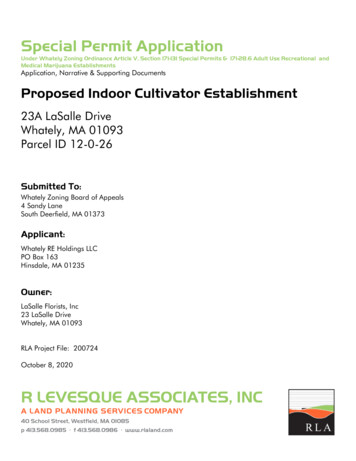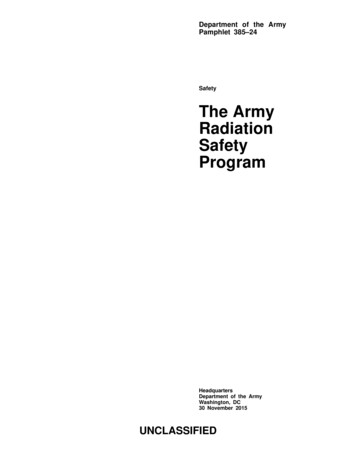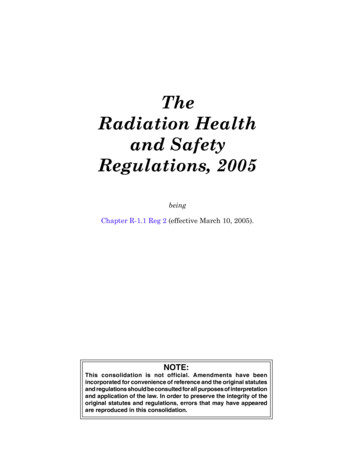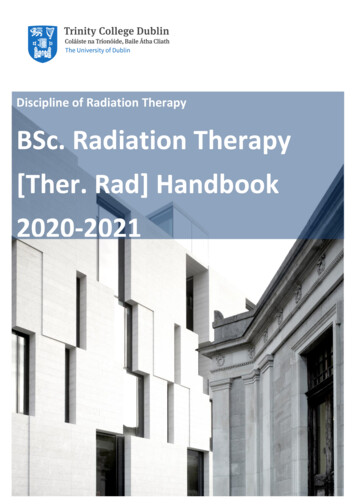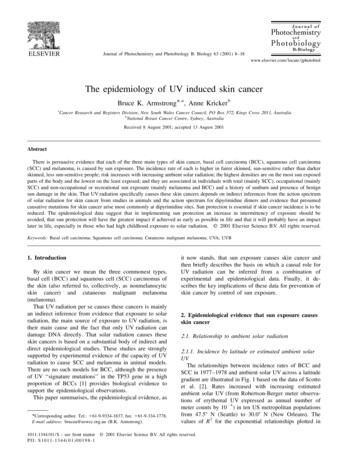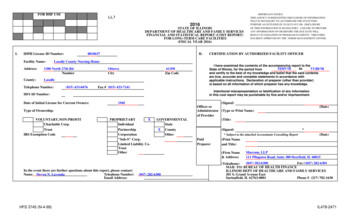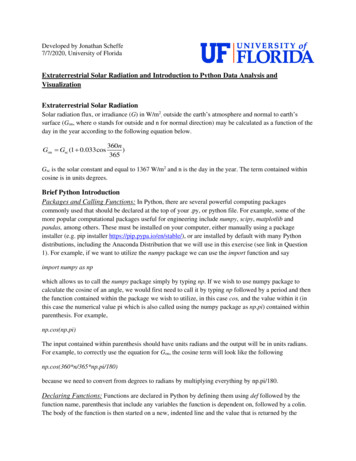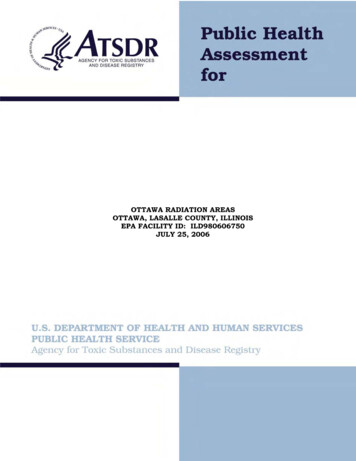
Transcription
OTTAWA RADIATION AREASOTTAWA, LASALLE COUNTY, ILLINOISEPA FACILITY ID: ILD980606750JULY 25, 2006
THE ATSDR PUBLIC HEALTH ASSESSMENT: A NOTE OF EXPLANATIONThis Public Health Assessment was prepared by ATSDR pursuant to the Comprehensive Environmental Response, Compensation, andLiability Act (CERCLA or Superfund) section 104 (i)(6) (42 U.S.C. 9604 (i)(6)), and in accordance with our implementing regulations(42 C.F.R. Part 90). In preparing this document, ATSDR has collected relevant health data, environmental data, and community healthconcerns from the Environmental Protection Agency (EPA), state and local health and environmental agencies, the community, andpotentially responsible parties, where appropriate.In addition, this document has previously been provided to EPA and the affected states in an initial release, as required by CERCLAsection 104 (i)(6)(H) for their information and review. The revised document was released for a 30-day public comment period.Subsequent to the public comment period, ATSDR addressed all public comments and revised or appended the document as appropriate.The public health assessment has now been reissued. This concludes the public health assessment process for this site, unless additionalinformation is obtained by ATSDR which, in the agency’s opinion, indicates a need to revise or append the conclusions previouslyissued.Agency for Toxic Substances & Disease Registry. Julie L. Gerberding, M.D., M.P.H., AdministratorHoward Frumkin, M.D., Dr.P.H., DirectorDivision of Health Assessment and Consultation . . William Cibulas, Jr., Ph.D., DirectorSharon Williams-Fleetwood, Ph.D., Deputy DirectorHealth Promotion and Community Involvement Branch .Susan J. Robinson, M.S., ChiefExposure Investigations and Consultation Branch. Susan M. Moore, Ph.D., ChiefFederal Facilities Assessment Branch . Sandra G. Isaacs, B.S., ChiefSuperfund and Program Assessment Branch .Richard E. Gillig, M.C.P., ChiefUse of trade names is for identification only and does not constitute endorsement by the Public Health Service or the U.S. Department ofHealth and Human Services.Additional copies of this report are available from:National Technical Information Service, Springfield, Virginia(703) 605-6000You May Contact ATSDR TOLL FREE at1-888-42ATSDRorVisit our Home Page at: http://www.atsdr.cdc.gov
Ottawa Radiation AreasFinal ReleasePUBLIC HEALTH ASSESSMENTOTTAWA RADIATION AREASOTTAWA, LASALLE COUNTY, ILLINOISEPA FACILITY ID: ILD980606750Prepared by:Illinois Department of Public HealthUnder Cooperative Agreement with theU.S. Department of Health and Human ServicesAgency for Toxic Substances and Disease Registry
Ottawa Radiation AreasFinal ReleaseTable of ContentsSummary . 1Purpose. 2Background . 2Site Location . 2Site History . 2Removal Activities. 3Discussion . 4Chemicals of Interest . 4Exposure Pathways . 4Completed Exposure Pathways. 4Toxicological Evaluation . 5Radium. 5Health Outcome Data. 5Community Health Concerns. 5Child Health Considerations . 6Conclusions. 6Recommendations. 6Public Health Action Plan. 6References. 8Figures. 11Attachments . 15ATSDR Glossary of Terms. 27
Ottawa Radiation AreasFinal ReleaseSummaryThe Ottawa Radiation Areas (ORA) site consists of 14 areas of contamination located throughoutthe city of Ottawa in LaSalle County, Illinois (Figure 1). The majority of the sites are located inresidential areas. Others are within the Ottawa business district or in light industrial areas. A fewsites are outside the city limits in unincorporated locations.Radium Dial, Inc. began operations in Ottawa, Illinois, in the late 1910s. Employees of bothRadium Dial, and later Luminous Processes, used radium-containing, luminous (glow-in-thedark) paints to coat the dials and faces of clocks, watches and other consumer products. DuringWorld War II, the company prepared luminous dials for military purposes.During operation, the building and the surrounding area became contaminated with radium-226.Several remedial activities have occurred at the site. All identified areas of contamination havebeen cleaned up with the exception of NPL-8 Frontage Property and NPL-11.Based on current site conditions, IDPH concludes that exposure to radium-226 in soil at NPL-11and NPL-8 poses a public health hazard. Residents, workers, and trespassers have a lowincreased risk of cancer from exposure to contaminated soil. USEPA is planning to clean upthese two remaining areas of contamination. The clean up should eliminate the exposure pathwayand prevent future exposures.1
Ottawa Radiation AreasFinal ReleasePurposeA Petitioned Public Health Assessment (PHA) was prepared for the Ottawa Radiation Areas in1993 by the Agency for Toxic Substances and Disease Registry (ATSDR). To update activitiesthat have occurred since 1993, the Illinois Department of Public Health (IDPH) has prepared anupdated PHA to determine whether radiation exposure is currently a public health hazard at theOttawa Radiation Areas site.BackgroundSite LocationThe Ottawa Radiation Areas (ORA) site consists of 14 areas of contamination (named NPL-1through NPL-14) located throughout the city of Ottawa in LaSalle County, Illinois (Figure 1).The majority of the sites are located in residential areas. Others are within the Ottawa businessdistrict or in light industrial areas. A few sites are outside the city limits in unincorporatedlocations.Site HistoryRadium Dial, Inc. began operation in Ottawa, Illinois, in the late 1910s. The company occupiedthe former Ottawa High School, located at Columbus and Washington Streets. The building wasthe Ottawa High School from 1880 until 1916, when the high school moved to its presentlocation. Radium Dial, Inc. operated in this building until 1930, when it moved to the corner ofColumbus and Washington Streets in Ottawa and changed the name of the company to LuminousProcesses, Inc. Between 1930 and 1968, the original Radium Dial building was used as a meatpacking plant and was later occupied by Farmers Co-op. This building was demolished in 1968.Employees of both Radium Dial and Luminous Processes used radium-containing, luminous(glow-in-the-dark) paints to coat the dials and faces of clocks and watches. During World War II,the company prepared luminous dials for military purposes. Most of the employees were women,and in 1916, Radium Dial, Inc. employed 92 women and five men (USEPA 2003a).After Luminous Processes ceased operations in 1978, the building remained empty, althoughresidents and city officials reported that it was used as a meat locker for several years.Until 1960, radium was the only radioactive material used at the facility. Radium was mixedwith zinc sulfide as the base for the luminous paints. The exact amount of radium used at thefacility between 1934 and 1957 is not known because no federal or state regulations existed atthat time for the receipt, use and distribution of radium in consumer products. In 1957, the Stateof Illinois passed a radioactive materials law, which required users of radioactive material toregister with the state, and to provide information about the types and quantities of radioactivematerials used. When Luminous Processes registered with the state in December 1957, thecompany indicated an average annual radium usage of 700 milligrams. Tritium became availablefor use in luminous paints in the 1970s and replaced radium.2
Ottawa Radiation AreasFinal ReleaseDuring operation, the building and the surrounding area became contaminated with radium-226.The building was demolished in 1985, and contaminated debris was transported for disposal at acommercial low-level waste disposal facility in Hanford, Washington. In 1986, a contractor forthe Illinois Department of Nuclear Safety (IDNS) removed contaminated soils, foundations andsewer lines. However, local residents made several allegations about improper disposal ofradioactive material. These allegations included improper disposal practices, the migration ofdust particles during demolition, and contamination of water when wastewater from hosing downthe foundation ran off into the sewer.In 1986 at the request of IDNS, the U.S. Department of Energy conducted an aerial survey of theCity of Ottawa to detect radium-contaminated areas. The survey identified approximately 11areas that contained varying levels of below ground radium contamination. Because radiumnaturally decays to form radon gas, in August 1986, IDNS conducted radon screening of homesin the Ottawa area. Radon-detecting equipment was placed in basements or low areas in homesto measure radon levels. Two homes had radon levels greater than USEPA’s standard of 4picoCuries per liter (pCi/L) of air. IDNS removed approximately 800 cubic feet of soil fromaround one of the homes. Another home had a radon system installed to remove the radon.In December 1986, IDNS requested USEPA’s assistance to perform site inspections, evaluatepossible movement of radium contamination, and supervise the clean-up plan (USEPA 2003a).Removal ActivitiesSeveral activities have occurred at the site to clean up contaminated areas. In 1988, radonreduction systems were installed in two homes and one business by USEPA. In 1990, USEPA,working with IDNS, began removing radium-contaminated soil from the radiation areas. Thematerial was transported to a low-level radioactive hazardous waste disposal facility in Utah.Of the 14 areas, USEPA prioritized residential properties and properties near residential areasbecause they posed a greater risk to the public (USEPA 2000). Between 1993 and 1997, USEPAconducted removal activities on 12 of the 14 sites. As part of the removal actions, USEPAexcavated contaminated soil greater than 6.2 picoCuries per gram (pCi/g) radium in theseresidential areas, including parts of NPL-11 (Figure 2). USEPA removed a total of 4,176 tons ofradium-contaminated soil at NPL-11 in 1996. The NPL-11 excavation was terminated due to thedifficulties of excavating material located below the water table.A Record of Decision was signed in September 2000 recommending complete removal ofradium-contaminated soil from three of the sites where future residential use is likely andremoval to 10 feet below ground surface at one site where future recreational use is planned.Remediation of the remaining properties is scheduled to take place beginning in 2007 andcontinuing through 2010.3
Ottawa Radiation AreasFinal ReleaseDiscussionChemicals of InterestIDPH compared the maximum concentration of each contaminant detected during environmentalsampling with appropriate screening values to select contaminants for further evaluation forcarcinogenic and non-carcinogenic health endpoints (Attachment 1). Chemicals that exceededcomparison values were selected for further evaluation.Comparison values are used only to screen for contaminants that should be evaluated further anddo not represent thresholds of toxicity. Though some of these chemicals may exist at levelsgreater than comparison values, they can only affect someone who is exposed and receives ahigh enough dose for adverse health effects to occur. Whether exposure to a chemical will causeadverse health effects depends on how much has entered the body, the duration of the exposure,how the chemical entered the body, and how the body responds. The chemical of interest at thissite is radium-226 (Tables 1 & 2).Exposure PathwaysAdverse health effects may occur when a contaminant reaches a receptor population through anexposure pathway. These pathways are separated into completed and potential pathways.Completed exposure pathways consist of five elements: 1) a source of contamination, 2)transport through an environmental medium, 3) a point of exposure, 4) a route of humanexposure, and 5) a receptor population. Potential exposure pathways have at least one elementmissing, but the missing element could exist. Potential exposure pathways suggest that exposurecould have occurred in the past, could be occurring, or could occur in the future. An exposurepathway is eliminated if one or more of the elements are missing and will never be present.Completed Exposure PathwaysAs part of the Record of Decision, USEPA calculated exposure estimates for the twounremediated areas, NPL-8 Frontage Property and NPL-11 (Figures 2 and 3). Surface andsubsurface soils have been contaminated with radioactive wastes. In addition, some buildings inthe Ottawa area contain elevated levels of radon gas.For NPL-11, a residential scenario was used to calculate exposure estimates. The risk at NPL-11is primarily to residents, construction workers and people walking through the area. They couldbe exposed to contamination by inhaling radon gas escaping from the ground, by touchingradium-contaminated soil, or from gamma radiation emitted by the contaminated soil. They alsocould get small particles of contaminated soil in their mouths by hand-to-mouth activity. Themost contaminated soil is located several feet below the surface and would not be contactedunless digging or excavation activities were occurring.USEPA estimated that there would be a low increased risk of cancer from exposure toradioactive contaminants at NPL-11 (Weston 1999). No noncancer health effects would beexpected.4
Ottawa Radiation AreasFinal ReleaseCurrently, for the NPL-8 frontage property, people who walk through the area 60 days or moreof the year could have a low increased risk of cancer (Weston 2003). No noncancer health effectswould be expected. Proposed plans for this property are for a commercial or industrial site. Theproperty will be remediated before any construction activities occur (USEPA 2003).Toxicological EvaluationRadiumRadium is naturally present in the environment at very low levels. Radium gives off gammaradiation that can cause adverse health effects at elevated levels. At the remaining two areas ofcontamination in Ottawa, people exposed to the low levels of radiation could have an increasedrisk of cancer. However, no studies exist to show what specific health effects may occur frombeing exposed to low levels of radium for a long period of time.At higher levels, radium has been shown to cause effects on the blood (anemia) and eyes(cataracts). It also has been shown to affect the teeth, causing an increase in broken teeth andcavities. Patients who were injected with radium in Germany, from 1946 to 1950, for thetreatment of certain diseases including tuberculosis were significantly shorter as adults thanpeople who were not treated (ATSDR 1990).Exposure to high levels of radium results in an increased incidence of bone, liver, and breastcancer. USEPA and the National Academy of Sciences, Committee on Biological Effects ofIonizing Radiation, have stated that radium is a known human carcinogen.Health Outcome DataThe IDPH Division of Epidemiologic Studies reviewed the incidence of cancer for the Ottawazip code 61350 from 1991 to 2000 (Attachment 2). In females, an increased risk of thyroidcancer was found with 2 cases expected and 7 cases observed. No other types of cancer wereelevated for either males or females. The most common types of cancer caused by exposure toradium are bone, liver, and breast. The presence of an increase in thyroid cancer does not appearto be related to contaminants from this site.Community Health ConcernsIDPH staff attended a public meeting held to discuss remediation activities. The meeting washeld on July 30, 2003 at Ottawa City Hall. Representatives from USEPA, IDPH, city officials,and the contractor for USEPA performing sampling and remediation work were present at themeeting. The meeting was held to discuss cleanup of two properties and to propose differentoptions for remediation. Community concerns included: Concern about children playing in contaminated soilHealth risks from contaminated soilCancer rates in the community5
Ottawa Radiation AreasFinal ReleaseIDPH answered health-related questions and informed residents that the Division ofEpidemiologic Studies would be evaluating cancer data to see if there was an increased rate ofcancer in the Ottawa zip code.This public health assessment was available for public comment from March 8, 2006 to April 22,2006. No comments were received.Child Health ConsiderationsIDPH and ATSDR recognize that children are especially sensitive to some contaminants. For thisreason, IDPH includes children when evaluating exposures to contaminants. Children are themost sensitive population considered in this health assessment because of their frequent hand-tomouth play habits. Children could have a low increased risk of cancer from exposure to radiumin the soil at NPL-11 and NPL-8.ConclusionsElevated levels of radium-226 exist in soil and exposure may occur in the future if they are notremoved. USEPA estimated that residents, workers, and trespassers have a low increased risk ofcancer from exposure to contaminated soil. Based on current site conditions, IDPH concludesthat exposure to radium-226 in soil at NPL-11 and NPL-8 poses a public health hazard. USEPAis planning to clean up these two remaining areas of contamination. This should eliminate theexposure pathway and prevent future exposures.RecommendationsIDPH recommends that:1. USEPA implement its plan to remediate NPL-8 Frontage Property and NPL-11.2. Residents take steps to limit their exposure to contaminated soil until remediation iscomplete.Public Health Action PlanUSEPA prioritized residential properties near residential areas because they posed a greater riskto the public. Between 1993 and 1997, USEPA conducted removal activities on 12 of the 14sites.On July 30, 2003, IDPH staff attended a public meeting held to discuss remediation activities.The meeting was held to discuss cleanup of two properties and to propose different options forremediation. IDPH also provided recommendations on how to reduce exposure to contaminantsin soil to residents who had concerns.In November 2004, the IDPH Division of Epidemiologic Studies reviewed the incidence ofcancer for the Ottawa zip code 61350 from 1991 to 2000 (Attachment 2).6
Ottawa Radiation AreasFinal ReleaseThe two remaining contaminated areas are scheduled to be cleaned up as soon as the finalremedial design report is approved. Currently, it is estimated that the remaining contaminatedproperties will be cleaned up beginning in 2007 and continuing through 2010.IDPH will continue to monitor USEPA activities at the Ottawa Radiation Areas site. An updatedhealth consultation will be completed once remediation of NPL-11 and NPL-8 Frontageproperties is complete.Preparer of ReportJennifer DavisEnvironmental ToxicologistIllinois Department of Public HealthReviewerKen RunkleEnvironmental ToxicologistIllinois Department of Public HealthATSDR Regional RepresentativeMark JohnsonRegional Operations, Office of the Assistant AdministratorATSDR Technical Project OfficersCharisse WalcottDivision of Health Assessment and ConsultationBeatrice Lunsford-WilkinsDivision of Health StudiesSylvia Allen-LewisDivision of Health Assessment and Consultation7
Ottawa Radiation AreasFinal ReleaseReferencesAgency for Toxic Substances and Disease Registry (ATSDR). 1990. Toxicological profile forradium. Atlanta: US Department of Health and Human Services; Dec. Report No.: TP-90-22.USEPA. February 2000. U.S. EPA Proposes Cleanup Plan Ottawa Radiation Areas – NPL-1,4,8,and 9 Superfund Sites Fact Sheet. Chicago: US Environmental Protection Agency.USEPA. February 2003a. Revised Community Involvement Plan: Ottawa Radiation Areas.Chicago: US Environmental Protection Agency. Publication No.: RFW128-2A-AMOI.USEPA. July 2003b. EPA Proposes Cleanup Plan for 2 Areas and Future Situations Fact Sheet.Chicago: US Environmental Protection Agency.Weston Solutions, Inc. October 1999. Risk Assessment Report, NPL-11 Site. Chicago:Publication No.:RFW011-2A-ADJJ.Weston Solutions, Inc. March 20, 2003. Screening Level Risk Assessment Report, OttawaRadiation Areas, NPL-8 Frontage Property. Chicago: Publication No.: RFW105-2A-AMRZ.8
Ottawa Radiation AreasFinal ReleaseTables9
Ottawa Radiation AreasFinal ReleaseTable 1. Radiological data summary of 0-2 feet below ground surface for NPL-8 FrontageProperty in Pico Curies per gram (Weston 2003).ChemicalRadium 226Frequency ofDetection32/32Range of DetectedConcentrations0.6-2895% UpperConfidence Limit8.159Background level of radium 226 is reported to be 1.2 pCi/g in soil.Table 2. Radiological data summary for NPL-11 in Pico Curies per gram (Weston 1999).ChemicalRadium 226Radium 226Frequency ofDetection7/73/3Range of nd level of radium 226 is reported to be 1.2 pCi/g in soil.See Figure 2 for areas A and B.10AreaAB
Ottawa Radiation AreasFinal ReleaseFigures11
Ottawa Radiation AreasFinal Release12
Ottawa Radiation AreasFinal Release13
Ottawa Radiation AreasFinal Release14
Ottawa Radiation AreasFinal ReleaseAttachments15
Ottawa Radiation AreasFinal ReleaseAttachment 1Comparison Values Used in Screening Contaminants for Further EvaluationEnvironmental Media Evaluation Guides (EMEGs) are developed for chemicals based ontheir toxicity, frequency of occurrence at National Priorities List (NPL) sites, and potential forhuman exposure. They are comparison values used only to select chemicals for furtherevaluation. They are developed without consideration for carcinogenic effects, chemicalinteractions, multiple routes of exposure, or other media-specific routes of exposure. They arevery conservative concentration values designed to protect sensitive members of the populations.Reference Dose Media Evaluation Guides (RMEGs) are another type of comparison valuederived to protect the most sensitive populations. They are developed without consideration forcarcinogenic effects, chemical interactions, multiple routes of exposure, or other media specificroutes of exposure. They are conservative concentrations.Cancer Risk Evaluation Guides (CREGs) are estimated contaminant concentrations based onone excess cancer in a million persons exposed to a chemical over a lifetime. These are alsoconservative values designed to protect sensitive members of the population.Maximum Contaminant Levels (MCLs) have been established by USEPA for public watersupplies to reduce the chances of adverse health effects from use of contaminated drinking water.These standards are well below levels for which health effects have been observed and take intoaccount the financial feasibility of achieving specific contaminant levels. These are enforceablelimits that public water supplies must meet.Lifetime Health Advisories (LTHAs) have been established by USEPA for drinking water andare the concentration of a chemical in drinking water that is not expected to cause any adverse,non-carcinogenic effects over a lifetime of exposure. These are conservative values thatincorporate a margin of safety.16
Ottawa Radiation AreasFinal ReleaseAttachment 2INCIDENCE OF CANCER IN ZIP CODE 61350 OFOTTAWA (LASALLE COUNTY), ILLINOIS1991-2000Prepared by theDivision of Epidemiologic StudiesIllinois Department of Public HealthNovember 200417
BackgroundThe Illinois Department of Public Health, Division of Environmental Health (DEH),contacted the Division of Epidemiologic Studies (DES), with a request to evaluate the cancerincidence in Ottawa (LaSalle County). The U. S. Environmental Protection Agency is movingforward with clean up plans at the remaining radium contaminated sites in Ottawa. DEH will bewriting a Public Health Assessment to update activities since 1993. DES collaborated with Centerfor Governmental Studies at Northern Illinois University on a previous study of this area whichwas completed in January 1998 and assessed cancer cases diagnosed between 1986 and 1992.1Since several more years of data are now available, Dr. Tiefu Shen, Chief of the Division ofEpidemiologic Studies, initiated a second evaluation to update the previous investigation.MethodsAnalyzing data for areas smaller than a ZIP code is difficult, not only because of smallnumbers but also the insufficient collection of address information for health data and the lack ofpopulation counts from the Census, which are necessary to calculate and compare rates. Theprevious report mentioned above defined the study area as eight census tracts specific to the areasof Ottawa where radium contamination sites were located (9626, 9627, 9628, 9636, and parts of9622, 9623, 9640, and 9637). In that study, however, about 20 percent of the cancer incidencecases were omitted from the analysis because they would not have been assigned to census tractsaccording to exact street level addresses. Cases that were assigned to census tracks 9622, 9623,9640 and 9637 were also omitted in the previous study because the radium sites were onlypartially in these tracks.118
Recognizing severe limitations faced by conducting cancer cluster evaluations at anygeographic areas smaller than a ZIP code, the Division current cluster assessment protocol callsfor the study area to be defined by ZIP code area. Often, the ZIP code information is available forall cases2 and its reporting accuracy is 99.9 percent.3 In the present study, the study area for thisevaluation was defined as ZIP code area 61350. Census tracks 9626, 9627, 9628, and 9636 usedin the previous study account for 61 percent of the population for ZIP code area 61350.All cases of cancer diagnosed among residents of the study area for the most recent tenyears of complete data at the time of the study, 1991-2000, were identified. The source for thesedata was the Illinois State Cancer Registry (ISCR). Identification of cancer cases in ISCR isdependent upon reporting by diagnostic and therapeutic facilities as mandated by state law.In addition, ISCR has agreements with other central cancer registries to send back Illinoiscancer data which are identified outside the state. These registries include Arkansas, California,Florida, Indiana, Iowa, Kentucky, Michigan, Mississippi, Missouri, North Carolina, Washington,Wisconsin, Wyoming, Barnes-Jewish Hospital in St. Louis, and the Mayo clinic in Minnesota.Completeness of out-of-state reporting depends upon the years of operation of these other centralregistries, the extent of their identification of out-of-state residents, and their standards of quality.Out-of-state diagnoses among residents of ZIP code area 61350 accounted for less than 3percent of the total number of cases reported and were included in the study. Completeness ofreporting from all reporting sources, assessed using the North American Association of CentralCancer Registries (NAACCR) Standard,4 is considered to be 96 percent complete for the period1991 through 2000.19
To benchmark and foster best practices among population-based registries, NAACCR hasd
Others are within the Ottawa business district or in light industrial areas. A few sites are outside the city limits in unincorporated locations. Site History . Radium Dial, Inc. began operation in Ottawa, Illinois, in the late 1910s. The company occupied the former Ottawa High School, located at Columbus and Washington Streets. The building was
